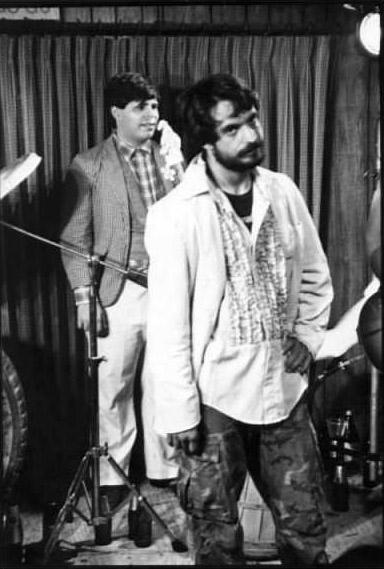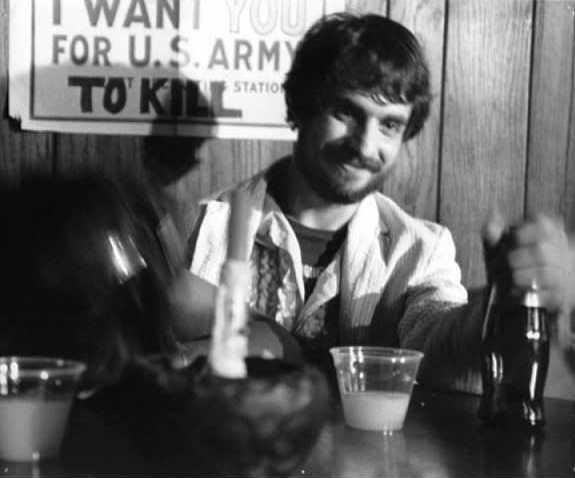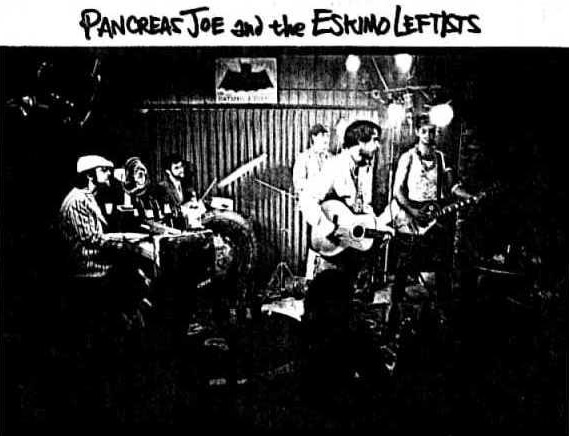The History of Pancreas Joe: Part 2
Pancreas Meets the Bubonic Squirrels
In late December, 1981 Rick purchased a 16 track tape unit for his recording studio. Wanting to break-in the unit, Rick agreed to record a song that celebrated a guitar Tony had purchased at the midnight swap meet across from the Capitol Records building in Hollywood. He had paid $30 for an old, used 6-string electric from a guitar dealer who was glad to unload it. The next day while hanging out at Santa Monica beach (which Tony did, as always, fully clothed), together with his friend Steve, he wrote a blues song called "Thirty Dollar Guitar".
Together with Tony and Rick in the studio was another friend, Phil (known in the band as Jensen Healy) an excellent guitarist from England. Before recording, the 3 spent time rewriting some of the lyrics and adding new lines. They spent 6 hours recording the song (under the influence of both legal and illicit intoxicants) with Phil playing all guitar parts and providing background vocals along with Rick, who also played piano, bass and drums. Tony sang the lead vocals. By the end of the evening they had recorded a 6 and a half minutes tribute to frustrated wannabe rock stars everywhere. The song’s rough blues sounded like a 1940’s Chicago nightclub. Tony decided that the band name he would use for the recording would be Pancreas Joe and the Bubonic Squirrels (having just heard that Griffith Park had an outbreak of plague amongst its squirrel population)
The next morning Rick and Tony invited some members of the band Fred (formerly Gutterspit)over to hear the song. It was decided to record an intro and club sounds to the background of the song to give it a live feel. So everyone acted like a group of rowdy club patrons, making it sound like a concert performance. Tony took a few tapes of the song and played them for friends, as did Rick.
About this time, the band Fred had begun to include the PJ & CA song "Legalize Suicide" into their performances at local LA clubs. Tony soon moved up to San Francisco, following Denny and Shawn, former PJ & CA members. "Thirty Dollar Guitar" looked like it was going to be relegated to being a memento and the last of Pancreas Joe.
Pancreas at the Movies
In May 1983 Tony decided to move back to Los Angeles, sharing an apartment with his friend Steve. Steve was finishing his last year of college at Cal State University, Northridge, where he was studying film. At the time, he was working on a project for school called Robotic Cakewalk, featuring music by Rick. It was the story of an army of toy robots who come to life and destroy the world. While the film earned him accolades at college, it didn't gain Steve anything in the film community. He decided his next project would be a music video, since they were the latest hot trend in short film. Steve had recently quit a increasingly commercial sounding Fred, and since the rift was less than amicable, didn't want to turn to them for a song. He remembered the $30 Guitar recording (which, after all, he had contributed lyrics to) and decided that would be the song he would put to film. After getting some feedback from Tony and Rick, Steve came up with a storyboard. He spent the next several months getting together the necessary funds. In the meantime, Tony had gone back into the studio with Rick and recorded 3 more blues songs. They were the Leadbelly classic "Black Betty", Muddy Water's "Manish Boy" and an original song written with Rick, "Pancreas Joe Blues."
Since some of the band's former members were not available, Steve used a couple of friends to fill in. Tony, Rick, and Kurt would appear as Pancreas, Dry Heave and the Professor from the earlier band, and Pat and Perry would fill-in as Johnny Maggot and Canker Sore (the real ones, Shawn and Denny, being in San Francisco). Steve also didn't think that Pancreas Joe and Bubonic Squirrels was good name, and Tony agreed. After some deliberating they came up with Pancreas Joe and the Eskimo Leftists.

In July 1984 Steve had gotten together enough funds to begin shooting. Rick's house was redone to represent the "Batman A Go-Go" the fictional haunt of the band. Other locations, including the Queen Mary and mansions in Beverly Hills, served as backdrops for the film. To fill the audience at the club, a cattle call was placed in a local film industry paper asking for extras who wished to participate in a music video. Steve Larner, who had also worked with Steve on Robotic Cakewalk, handled the camera work. Tony's only stipulation in allowing the song to be filmed was that it be done in black and white. Steve readily agreed, since the 40s sound lent itself well to b & w and it would also be less expensive than color. Over the next month the film was shot, with most of the work being done over two weekends.
Tony was sure it would be a nice remembrance to have in later years, but didn't expect much more than that. Steve spent most of the next month and a half editing the film and having the post production sound work done. When he finally showed the film to Tony and Steve Larner they were both amazed. It looked very much like what they were seeing on the newly created MTV. But with a sense of humor. The first showings that Steve arranged were at a local revival theater, The Nuart in Santa Monica. The film played between features for a week (which, Steve hoped, would perhaps make it available for Academy Award consideration as a short film.) He entered it in two film festivals, New York's Movies on a Shoestring and the San Jose Media Association Film Awards. It won at both, taking best music video and best short subject, respectively. But Steve had set higher sights for national recognition.

MTV Meets the Eskimo Leftists
MTV had started a weekly contest where unsigned bands could send in a video, have it shown and voted upon by the viewing audience. The grand prize was a record contract. The program was known as MTV Basement Tapes. Steve sent a video of the $30 Dollar film and within a week had gotten a letter back saying that the film would be shown the following month. Tony had by this time moved back to San Francisco. Not expecting anything to come from the video, and feeling that he needed to make a change in his life, he had enlisted in the Army as soon as he had gotten back. When Steve called with the news that he was going to be on MTV, he was taken aback but still felt that he needed to go into the military. Unfortunately, the date set for the showing of the video was 10 days after he would be in basic training.
On Oct 9, 1984 Martha Quinn announced to the MTV audience "Here's Pancreas Joe and Eskimo Leftist with $30 Guitar." The video clip, trimmed down to exactly six minutes, came in third that night out of six videos, getting 12% of the vote. It would go on to be shown twice more on MTV in 1985, once during a "Best of Basement Tapes" program, and again by Weird Al Yankovic, on one of his "Al TV" segments. The video also got airplay on the local ABC video show, "Goodnight LA" as well as other local music video programs. The video became part of package tour of videos by unsigned bands, which played in clubs around the country. One DJ commented that PJ & EL were "the greatest unknown band in the world". All the while Pancreas himself, Tony, was being all he could be.
Cows In Action
After going through all of his army training, Tony wound up at Fort Bliss, Texas outside El Paso. There he met a few people who also shared an interest in music and he convinced the company commander to allow him to form a folk music group. In early 1986 Tony formed CIA or Cows In Action. They practiced twice weekly for a few months (getting out of calisthenics in the process) and worked on songs by Neil Young and Bob Dylan, as well as working up an acoustic version of $30 Dollar Guitar. In May of that year they played their only concert at a company charity event, which has also been the only live performance of the Pancreas signature song, $30 Dollar. In August of 1986 Tony was discharged (honorably, of all things) and returned to the Bay Area. Go to the History of Pancreas Joe: Part 3.
The History of Pancreas Joe:
Part 1 Part 2 Part 3
Meet Pancreas Joe | Pancreatic Secretions | Home